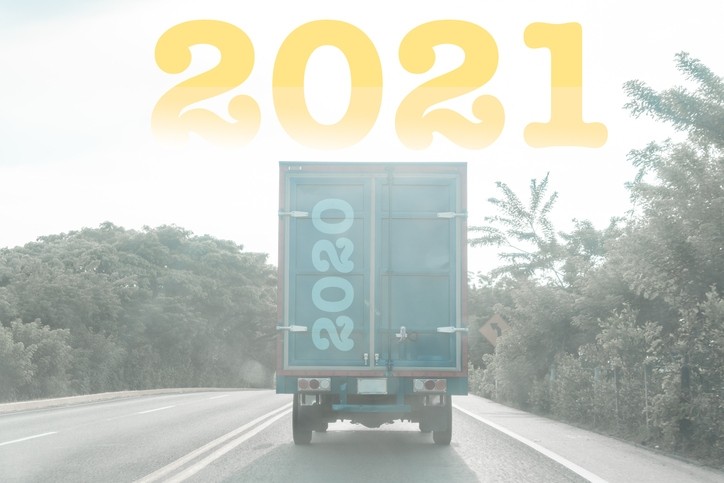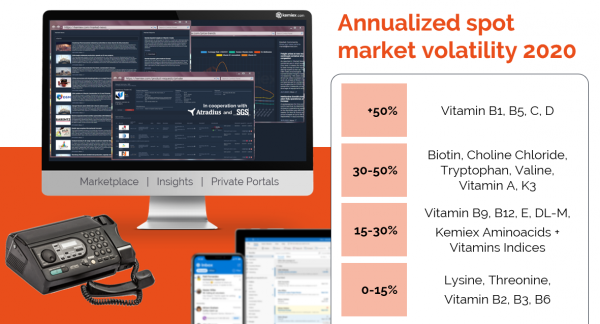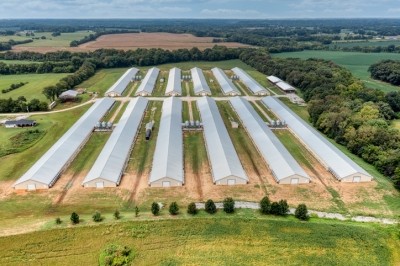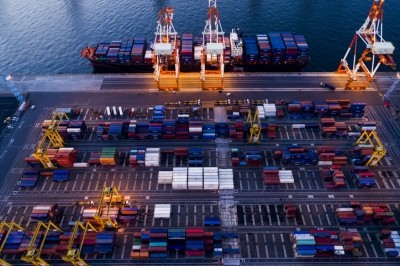Volatile markets for vitamins, amino acids and freight set to continue into 2021

Significant price swings are calling for proper risk management strategies to avoid financial losses, says Stefan Schmidinger, partner, Kemiex.
Such price fluctuations pose a significant P&L risk to companies, as missing a good timing for a deal can cost tens of thousands of dollars, he stressed.
Several producers of vitamins and amino acids have closed the books for 2020 and have stopped accepting inquiries for short-term orders, including the major vitamin B1 and Dl-Methionine producers, said Kemiex. “Given the current freight situation, Asian producers are only willing to accept orders from February or March 2021 shipment and will levy high surcharges for earlier shipment.”
Freight headaches continue
The supply side is significantly affected by unprecedented logistics related costs and shipping bottlenecks, said the analysts.
Multiple producers and exporters in the Asia-Pacific region (APAC) report shortfalls due to freight costs exceeding their previous calculations. In some cases, arrangements with buyers could be achieved but additional margin pressure is reflected in increasing raw material prices. The freight situation has already led to some shipments not being offered before March, as per Kemiex data.
Freight prices are reaching new record highs every week amid continued container shortage, and port congestion, stressed Schmidinger.
Sea freight data from Freightos Baltic Index (FBX) and Shanghai Shipping Exchange (SSE) suggests that prices are reaching new highs driven by trade lanes to Europe and South America. In many cases, carriers or forwarders are adding various types of surcharges, and global schedule reliability is down to new lows.
In the UK, the analysts outlined how importers are seeking to frontload ahead of the Brexit deadline, which is also causing container surcharges and delays, while major US ports report vessels anchoring, waiting for berth space amid labor and equipment shortages.
“US exporters have also voiced frustration in recent weeks, saying ocean carriers are moving empty containers back to Asia rather than waiting for agricultural exports,” said Schmidinger.
Aircraft utilization is on similar (peak) levels as in the first half of 2020 amid market demand that is continuously outperforming capacity especially out of APAC, he reported. “The ground handling situation remains critical across all key economies due to COVID-19 safety measures. The market situation is expected to remain similar for the first quarter of 2021 and longer with also short-term impacts from COVID-19 vaccine distribution expected.”
Rail freight rates have leaped five-fold on the back of enormous demand and lack of equipment, between US$6,000 and US$10,000 per 40ft high-cube container, said Kemiex. Meanwhile, a container backlog on China’s border with Kazakhstan has prompted a temporary suspension of some westbound services, it added.
And logistics related developments breaking this morning - the port of Dalian in China, which is central to amino acids and ingredient export, has just closed, putting shipments in limbo. "There would seem to be COVID-19 testing measures being implemented in the area,” Schmidinger said, citing a China-based industry source.
Product news
The 75/25 joint venture of DSM and Nenter in China has released the first intermediates while vitamin E production is set to only start in January or February 2021, reported the Swiss analysts.
They also highlighted how, due to uncertainties generated by an antidumping petition against imports of methionine from France, Japan and Spain, Adisseo has decided to discontinue exports of Rhodimet NP99 (Dl-Methionine) from France into the US after February 2021. Adisseo said it may reevaluate this position after the final decision is made public in those US proceedings, in September 2021. The company is set to open a new methionine production facility in Nanjing, in China, mid-2022.
Indian Fermenta Biotech, through its US subsidiary, has acquired a 52% membership interest in AGD Nutrition LLC to facilitate exports and enhance its footprint in North America. AGD was founded in 2002 and is specialized in animal nutrition and dietary supplements across North America, reporting a turnover of US$7.9m in 2019, according to Kemiex.
And the Luxi Chemical Group, which is based in China's Shandong Province, has announced that a new formic acid facility with an annual manufacturing capacity of 400,000 t/a has been approved. The construction of that company's fourth production facility is underway as planned and will result in a total capacity of 800,000 t/a when completed, said the feed additive market specialists.
EU authorizations
Looking at a raft of recent EU regulatory developments, Kemiex noted that the authorization of L-Lysine monohydrochloride produced by C. glutamicum DSM 32932 (Evonik) and L-Lysine sulfate produced by C. glutamicum KFCC 11043 (CJ Europe) as feed additives for all animal species has entered into force.
The EU Commission (EC) has also renewed the authorization of L-Histidine produced by E. coli ATCC 9637 as a feed additive for salmonids, extending use to other finfish (Kyowa Hakko Europe).
Moreover, the regulator has authorized the use of selenomethionine produced by S. cerevisiae CNCM I-3399 (Phileo Lessaffre) as well as 6-phytase produced by K. phaffii DSM 32854 (Huvepharma).
The EC also recently approved L-Valine produced by Escherichia coli KCCM 80159 (Daesang Europe) and monosodium glutamate (MSG) produced by fermentation with Corynebacterium glutamicum KCCM 80188 (CJ Europe) as a feed additive for all animal species, as well as 6-phytase produced by Komagataella phaffii CGMCC 12056 (Andrés Pintaluba SA) for laying hens and birds, L-Glutamine produced by C. glutamicum NITE BP-02524 (Ajinomoto Animal Nutrition Europe) and iron chelate of lysine and glutamic acid (Zinpro Animal Nutrition Europe) as a feed additive for all animal species.
Meanwhile, the European Food Safety Authority (EFSA) has confirmed the safety of vitamin B12 in the form of cyanocobalamin produced by E. adhaerens CNCM‐I 5541 for all animal species. In a 2018 assessment, the FEEDAP panel could not conclude on a scientific opinion. The case was submitted by FEFANA.
















